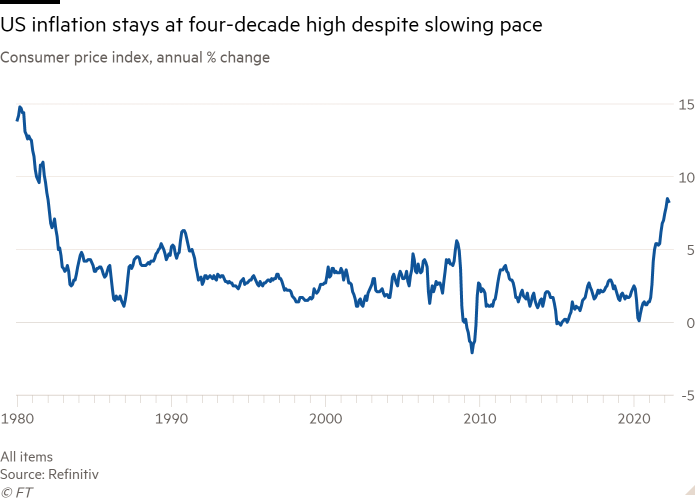US consumer prices rose at an annual pace of 8.3 per cent last month, more than economists’ expectations and staying at a four-decade high, underscoring the urgency of the Federal Reserve’s push to stamp out inflation.
Although the consumer price index moderated for the first time in eight months — it was a step down from the 8.5 per cent increase recorded in March — it was slightly higher than economists’ expectations of an 8.1 per cent rise. An underlying gauge of inflation also rose more than expected, highlighting stresses on households and the challenge for the Biden administration.
The data initially jolted the $22tn market for US government bonds. The two-year Treasury yield, which is most sensitive to the outlook for monetary policy, jumped roughly 0.12 percentage points to 2.73 per cent, before dropping back down to 2.64 per cent. The yield on the benchmark 10-year note was back below 3 per cent in afternoon trading.
US stocks also retreated, led by a sell-off in tech, with the Nasdaq Composite down 2.5 per cent and the S&P 500 1 per cent lower.
“This is not the surprise either the bond market or the Fed wanted,” said Emily Roland, co-chief investment strategist at John Hancock Investment Management.
In addition to the jump in prices from last year, consumer prices climbed another 0.3 per cent from the previous month. That was slower than the 1.2 per cent rise recorded in March, which was fuelled by soaring energy and food costs tied to Russia’s invasion of Ukraine.
Shelter, food, airline fares and new vehicles were the largest contributors to CPI last month. However, weakness in energy prices helped contain overall inflation, with the gasoline index falling 6.1 per cent month on month. That offset increases in the cost of natural gas and electricity, the Bureau of Labor Statistics, which published the data, said.
Stripping out volatile items such as food and energy, however, the monthly rise in core CPI increased 0.6 per cent last month, compared with 0.3 per cent in March. On an annual basis, that amounted to a 6.2 per cent increase.

Economists homed in on a 0.7 per cent monthly jump in underlying services inflation, which excludes energy services. Since December, that rate has steadily increased and year over year is up nearly 5 per cent.
The latest uptick solidified concerns that price pressures were no longer a phenomenon exclusive to sectors most affected by pandemic-related disruptions — but rather a broad-based trend affecting all sectors.
“This moves the balance of risks to more concern about inflation going forward,” said Eric Stein, chief investment officer for fixed income at Eaton Vance.
Nonetheless, the data may represent the beginning of a peak in the coronavirus pandemic-era inflation surge caused by red-hot consumer demand coupled with severe supply chain bottlenecks.
Economists broadly expect the pace of consumer price growth to moderate further from these levels as the immediate effects of the war in Ukraine abate. The headline annual inflation reading should also start to fall in the coming months as it starts being compared with the very elevated levels logged last year.
President Joe Biden on Wednesday said it was “heartening” to see a moderation in the annual figure, but “the fact remains that inflation is unacceptably high”. “Inflation is a challenge for families across the country and bringing it down is my top economic priority,” he said.
The Fed has increased its efforts to contain price pressures, implementing its first half-point rate rise in more than two decades this month. Further such increases are expected in June and July, and potentially even September, with the federal funds rate expected to reach 2.7 per cent by the end of the year.
The Fed’s reduction of its $9tn balance sheet will also commence in June, the second of two levers it is using to cool the economy.
The main question for investors is whether the US central bank can bring down inflation without causing a recession. John Williams, the president of the New York Fed, said this week the challenge of engineering a soft landing would be difficult but “not insurmountable”.
The latest inflation figures “certainly exacerbate a job that was already pretty difficult in terms of the Fed’s ability to engineer a soft landing,” said Roland at John Hancock. “If inflation remains elevated, it is going to become much harder.”

